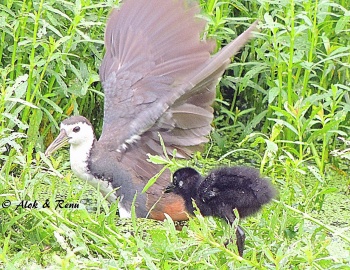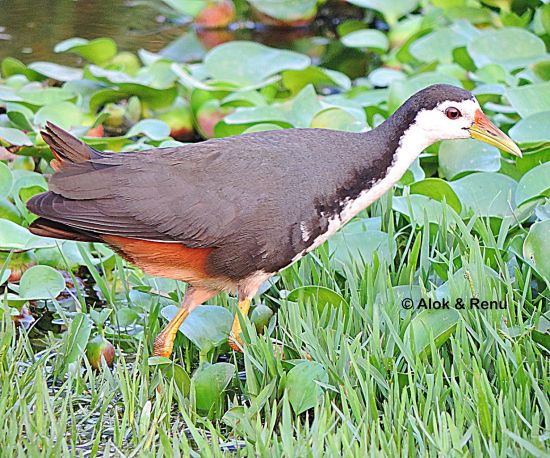Aloktewari (talk | contribs) (Song - call by one individual) |
(taxon, refs) |
||
| (9 intermediate revisions by 4 users not shown) | |||
| Line 1: | Line 1: | ||
| − | [[Image:White- | + | [[Image:White-breasted_Waterhen_Alok.JPG|thumb|550px|right|Nominate subspecies<br />Photo by {{user|aloktewari|Alok Tewari}}<br />Basai Wetland, Gurugram, Haryana, [[India]], 31 March 2015]] |
;[[:Category:Amaurornis|Amaurornis]] phoenicurus | ;[[:Category:Amaurornis|Amaurornis]] phoenicurus | ||
| Line 5: | Line 5: | ||
==Identification== | ==Identification== | ||
28–33 cm (11-13 in)<br /> | 28–33 cm (11-13 in)<br /> | ||
| − | Dark grey upperparts and flanks, white face, neck and breast, cinnamon belly and undertail. The body is flattened laterally to allow easier passage through the reeds or undergrowth. They have long toes, a short tail and a yellow bill and legs. Sexes are similar, but immature birds are much duller versions of the adults. The downy chicks are black.<sup>[[#References|[ | + | Dark grey upperparts and flanks, white face, neck and breast, cinnamon belly and undertail. The body is flattened laterally to allow easier passage through the reeds or undergrowth. They have long toes, a short tail and a yellow bill and legs. Sexes are similar, but immature birds are much duller versions of the adults. The downy chicks are black.<sup>[[#References|[4]]]</sup> |
==Distribution== | ==Distribution== | ||
| − | [[Image:white-breasted_waterhen_alok.JPG|thumb|350px|right| | + | [[Image:white-breasted_waterhen_alok.JPG|thumb|350px|right|Nominate subspecies, fledgling with parent<br />Photo by {{user|aloktewari|Alok Tewari}}<br />Dist. Muzaffarnagar, Uttar Pradesh, [[India]], Aug 2013]] |
| − | Southern [[Asia]], the [[Philippines]], the [[Malaya|Malay]] Archipelago and many smaller islands including the [[Maldives]]<sup>[[#References| | + | Southern [[Asia]], the [[Philippines]], the [[Malaya|Malay]] Archipelago and many smaller islands including the [[Maldives]]<sup>[[#References|3]]</sup>, [[Nicobar Islands]], [[Sulawesi]], [[Moluccas]], and the [[Lesser Sunda Islands]]. |
==Taxonomy== | ==Taxonomy== | ||
| − | [[Plain Bush-hen]] (''A. olivacea''), [[ | + | [[Plain Bush-hen]] (''A. olivacea''), [[Pale-vented Bush-hen]] (''A. moluccana''), and [[Talaud Bush-hen]] (''A. magnirostris'') were formerly considered conspecific within White-breasted Waterhen. |
====Subspecies==== | ====Subspecies==== | ||
| − | + | Clements recognizes these subspecies[[#References|[1]]]: | |
*''A. p. phoenicurus'' - Southern [[Asia]], [[Malaya|Malay]] Archipelago and [[Philippines]] Islands | *''A. p. phoenicurus'' - Southern [[Asia]], [[Malaya|Malay]] Archipelago and [[Philippines]] Islands | ||
| − | *''A. p. insularis'' - [[Andaman and Nicobar Islands]] | + | *''A. p. insularis'' - Andaman and South Nicobar Islands in the [[Andaman and Nicobar Islands]] |
| + | *''A. p. leucocephala'' - Car Nicobar Island | ||
*''A. p. midnicobarica'' - Central Nicobar Islands | *''A. p. midnicobarica'' - Central Nicobar Islands | ||
*''A. p. leucomelana'' - [[Sulawesi]], western [[Moluccas]] and [[Lesser Sundas]] | *''A. p. leucomelana'' - [[Sulawesi]], western [[Moluccas]] and [[Lesser Sundas]] | ||
| Line 22: | Line 23: | ||
==Behaviour== | ==Behaviour== | ||
====Breeding==== | ====Breeding==== | ||
| − | They nest in a dry location on the ground in marsh vegetation, laying 6-7 eggs.<sup>[[#References|[ | + | They nest in a dry location on the ground in marsh vegetation, laying 6-7 eggs.<sup>[[#References|[4]]]</sup> |
====Diet==== | ====Diet==== | ||
| − | They probe in mud or shallow water; or they forage on the ground or in low bushes and small trees. The diet includes insects, small fish and seeds. <sup>[[#References|[ | + | They probe in mud or shallow water; or they forage on the ground or in low bushes and small trees. The diet includes insects, small fish and seeds. <sup>[[#References|[4]]]</sup> |
====Vocalisation==== | ====Vocalisation==== | ||
| − | Call recorded at the beginning of spring, many individuals were calling.<br /> | + | Call recorded at the beginning of spring, many individuals were calling. |
| − | + | <br /> | |
| − | + | <br /> | |
| + | {{ Audio|White-breasted_waterhen_alok.mp3 }} | ||
| + | |||
Recording by {{user|aloktewari|Alok Tewari}}<br /> | Recording by {{user|aloktewari|Alok Tewari}}<br /> | ||
[[Bharatpur Keoladeo National Park]], [[India]], February-2016<br /> | [[Bharatpur Keoladeo National Park]], [[India]], February-2016<br /> | ||
| − | Call by one individual sitting in a bush on the edge of a water-body, can be heard in the recording below :<br /> | + | Call by one individual sitting in a bush on the edge of a water-body, can be heard in the recording below : |
| − | + | <br /> | |
| − | + | <br /> | |
| + | {{ Audio|White-breasted_waterhen_alok_2.mp3 }} | ||
| + | |||
Recording by {{user|aloktewari|Alok Tewari}}<br /> | Recording by {{user|aloktewari|Alok Tewari}}<br /> | ||
Delhi, [[India]], August-2012<br /> | Delhi, [[India]], August-2012<br /> | ||
| + | |||
==References== | ==References== | ||
| − | #[http://www.birdforum.net/showthread.php?t=122233 Thread] in Id forum of Birdforum | + | #{{Ref-Clements6thOct23}}#{{Ref-GillDonskerRasmussen22V13.2}}#[http://www.birdforum.net/showthread.php?t=122233 Thread] in Id forum of Birdforum |
| − | + | #Wikipedia | |
{{ref}} | {{ref}} | ||
==External Links== | ==External Links== | ||
| − | {{GSearch|Amaurornis | + | {{GSearch|"Amaurornis phoenicurus" {{!}} "White-breasted Waterhen"}} |
| + | {{GS-checked}}1 | ||
| + | <br /> | ||
<br /> | <br /> | ||
| − | |||
| − | [[Category:Birds]][[Category:Amaurornis | + | [[Category:Birds]][[Category:Amaurornis]] [[Category:Bird Songs]] |
Latest revision as of 01:46, 23 December 2023
- Amaurornis phoenicurus
Identification
28–33 cm (11-13 in)
Dark grey upperparts and flanks, white face, neck and breast, cinnamon belly and undertail. The body is flattened laterally to allow easier passage through the reeds or undergrowth. They have long toes, a short tail and a yellow bill and legs. Sexes are similar, but immature birds are much duller versions of the adults. The downy chicks are black.[4]
Distribution

Photo by Alok Tewari
Dist. Muzaffarnagar, Uttar Pradesh, India, Aug 2013
Southern Asia, the Philippines, the Malay Archipelago and many smaller islands including the Maldives3, Nicobar Islands, Sulawesi, Moluccas, and the Lesser Sunda Islands.
Taxonomy
Plain Bush-hen (A. olivacea), Pale-vented Bush-hen (A. moluccana), and Talaud Bush-hen (A. magnirostris) were formerly considered conspecific within White-breasted Waterhen.
Subspecies
Clements recognizes these subspecies[1]:
- A. p. phoenicurus - Southern Asia, Malay Archipelago and Philippines Islands
- A. p. insularis - Andaman and South Nicobar Islands in the Andaman and Nicobar Islands
- A. p. leucocephala - Car Nicobar Island
- A. p. midnicobarica - Central Nicobar Islands
- A. p. leucomelana - Sulawesi, western Moluccas and Lesser Sundas
Habitat
Marshes.
Behaviour
Breeding
They nest in a dry location on the ground in marsh vegetation, laying 6-7 eggs.[4]
Diet
They probe in mud or shallow water; or they forage on the ground or in low bushes and small trees. The diet includes insects, small fish and seeds. [4]
Vocalisation
Call recorded at the beginning of spring, many individuals were calling.
Recording by Alok Tewari
Bharatpur Keoladeo National Park, India, February-2016
Call by one individual sitting in a bush on the edge of a water-body, can be heard in the recording below :
Recording by Alok Tewari
Delhi, India, August-2012
References
- Clements, J. F., P. C. Rasmussen, T. S. Schulenberg, M. J. Iliff, T. A. Fredericks, J. A. Gerbracht, D. Lepage, A. Spencer, S. M. Billerman, B. L. Sullivan, and C. L. Wood. 2023. The eBird/Clements checklist of Birds of the World: v2023. Downloaded from https://www.birds.cornell.edu/clementschecklist/download/
- Gill, F, D Donsker, and P Rasmussen (Eds). 2023. IOC World Bird List (v 13.2). Doi 10.14344/IOC.ML.13.2. http://www.worldbirdnames.org/
- Thread in Id forum of Birdforum
- Wikipedia
Recommended Citation
- BirdForum Opus contributors. (2024) White-breasted Waterhen. In: BirdForum, the forum for wild birds and birding. Retrieved 5 June 2024 from https://www.birdforum.net/opus/White-breasted_Waterhen
External Links
GSearch checked for 2020 platform.1




